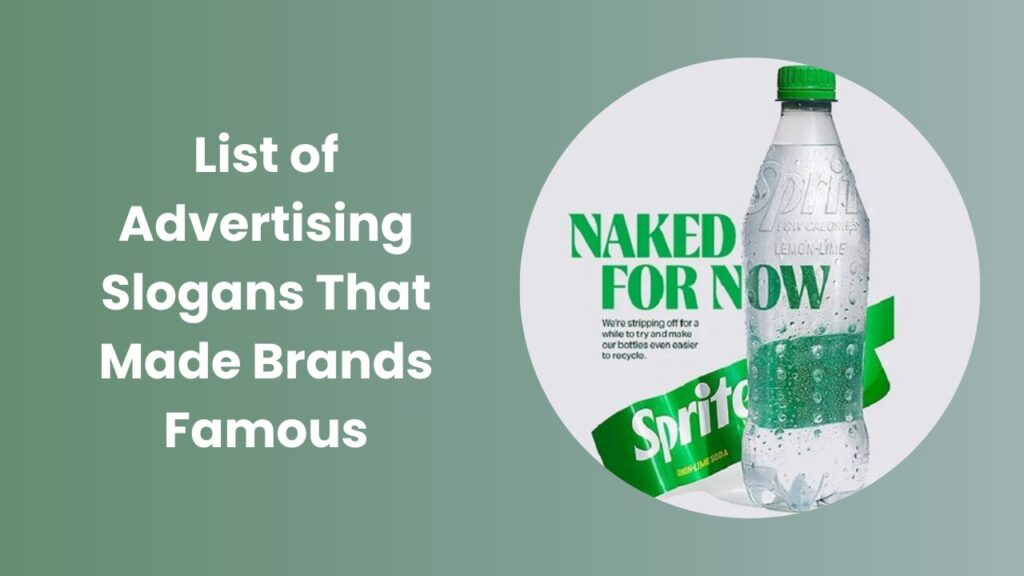Advertising slogans are far more than catchy phrases; they are essential elements of brand identity and marketing strategy. A well-crafted slogan can capture the essence of a brand, evoke emotion, and leave a lasting impression on consumers. From globally recognized corporations to local favorites, advertising slogans help define how audiences perceive products and services. This comprehensive list of advertising slogans showcases memorable taglines that have influenced culture, advertising, and consumer behavior around the world, highlighting why they remain relevant today. Slogans are the backbone of advertising campaigns because they condense complex ideas into simple, memorable language that resonates across demographics and cultures.
The Importance of Advertising Slogans
Slogans act as the voice of a brand, condensing complex messages into a few simple, memorable words. They differentiate a company from competitors, create emotional resonance, and reinforce loyalty. A strong slogan communicates not only what a brand offers but also what it stands for. Beyond marketing, slogans reflect a company’s vision, values, and personality. They have the power to inspire, motivate, and connect with audiences on a deeply personal level. The following examples highlight some of the most impactful slogans and the strategies behind their enduring success. Understanding these can also teach marketers how to craft messages that stick, create emotional bonds with consumers and elevate their brands over time.
List of advertising slogans
Nike: Just Do It
Nike’s “Just Do It,” launched in 1988, is a masterclass in motivational advertising. Beyond promoting athletic gear, it encourages action, perseverance, and self-empowerment. Its simplicity makes it universally relatable, while its emotional undertone inspires consumers to push beyond limits. The slogan transforms wearing Nike products into a statement of determination and ambition. Nike also leveraged this slogan across multi-channel campaigns, including advertisements featuring elite athletes and everyday people, which reinforced the message that anyone can achieve greatness. This slogan demonstrates how a brand can successfully merge emotional appeal with performance messaging, making it timeless.
McDonald’s: I’m Lovin’ It
Introduced in 2003, McDonald’s slogan “I’m Lovin’ It” combines simplicity with positivity. Rather than focusing solely on food, it emphasizes the emotional experience of enjoyment, comfort, and connection. The phrase resonates with families and young audiences by highlighting everyday moments of pleasure, such as sharing meals with friends or celebrating small victories. Its global reach required careful adaptation to different languages and cultures, which showcases how a slogan can maintain brand consistency while remaining culturally sensitive. The slogan’s enduring presence proves the power of aligning marketing with emotional storytelling and relatability.
Apple: Think Different
Apple’s “Think Different,” launched in 1997, celebrates creativity, innovation, and individuality. Unlike conventional product-focused campaigns, this slogan focuses on mindset and values. It appeals to consumers who see themselves as pioneers and innovators, reinforcing Apple’s image as a brand that empowers original thinking. By emphasizing aspiration over products, Apple differentiated itself in the competitive tech market. The campaign also featured images of iconic visionaries, which reinforced the message that Apple is synonymous with creativity and progress. This slogan exemplifies how a tagline can extend brand influence beyond tangible goods to cultural relevance, inspiring not just purchases but personal identification with the brand.
Coca-Cola: Open Happiness
Coca-Cola’s “Open Happiness,” introduced in 2009, conveys joy, connection, and shared experiences. Rather than emphasizing the beverage itself, it focuses on the emotional satisfaction of drinking Coca-Cola. The slogan evokes warmth, togetherness, and celebration, making the product synonymous with happiness. Campaigns often feature moments of friendship, community gatherings, and joyful celebrations, reinforcing the slogan’s emotional message. Coca-Cola demonstrates how slogans can transform a simple commodity into a memorable lifestyle experience. Its global recognition shows the importance of emotional resonance in marketing and the enduring power of consistency across decades.
L’Oréal: “Because You’re Worth It”
L’Oréal’s “Because You’re Worth It,” launched in 1973, speaks directly to consumer self-esteem and empowerment. It positions beauty products as affirmations of personal value and self-expression. By appealing to emotions and psychological needs, L’Oréal built a strong connection with its audience. The slogan conveys confidence, individuality, and aspiration, making it relatable and aspirational for millions worldwide. L’Oréal’s advertising campaigns often emphasize real women and relatable experiences, reinforcing the slogan’s empowering message. Its longevity illustrates the lasting power of emotionally-driven marketing that aligns with cultural and societal trends.
De Beers: A Diamond is Forever
Crafted in 1947, De Beers’ slogan “A Diamond is Forever” conveys durability, love, and emotional significance. Beyond marketing diamonds, it shaped cultural perceptions of engagement and commitment. The slogan’s simplicity and timelessness have made it a global standard for romance. De Beers’ campaigns reinforced the idea that diamonds symbolize eternal love, influencing not only consumer behavior but also the jewelry industry as a whole. This slogan shows how advertising can extend beyond products to shape cultural norms, turning a commodity into a meaningful symbol.
KFC: Finger Lickin’ Good
KFC’s “Finger Lickin’ Good” has delighted audiences since the 1950s by emphasizing the sensory pleasure of eating fried chicken. The slogan communicates taste, enjoyment, and indulgence in a playful manner. By highlighting the fun experience of eating KFC, it reinforces the brand’s identity and encourages repeat engagement. Over time, the slogan became an essential part of KFC’s personality, showing how a tagline can embody a brand’s tone and create familiarity with consumers.
M&M’s: Melts in Your Mouth, Not in Your Hands
M&M’s slogan, introduced in 1954, combines wit with practicality. By highlighting the candy’s unique selling point, it appeals to both children and adults. Its humor and clarity make the product memorable and enjoyable. Marketing campaigns often reinforced this slogan by emphasizing playful scenarios and the candy’s fun, shareable nature. This slogan illustrates how emphasizing convenience, quality, and entertainment can create an enduring brand message that resonates across generations.
BMW: The Ultimate Driving Machine
BMW’s “The Ultimate Driving Machine,” introduced in the 1970s, positions the brand as a leader in performance and engineering. It appeals to consumers who value driving experience, luxury, and precision. The slogan emphasizes lifestyle and aspiration, turning every journey into a statement of sophistication. BMW has consistently reinforced this message through marketing that highlights both technological innovation and the emotional thrill of driving. Its continued relevance highlights the importance of clarity and power in creating a tagline that defines brand identity and strengthens consumer trust.
Disneyland: The Happiest Place on Earth
Disneyland’s slogan, “The Happiest Place on Earth,” captures the magic and wonder of the theme park. Introduced in the 1950s, it promises joy, imagination, and unforgettable experiences for families. By focusing on emotions rather than attractions, the slogan has elevated Disneyland to a cultural phenomenon. Disney’s marketing reinforces the slogan through storytelling, immersive experiences, and media campaigns, making it a perfect example of how slogans can convert physical destinations into emotional experiences. It demonstrates how branding and emotional resonance can create lifelong loyalty.
The Role of Emotional Branding in Advertising
Emotional branding is one of the most effective strategies in marketing. Slogans that evoke feelings of empowerment, joy, or nostalgia create stronger connections than those focusing solely on product features. The examples explored in this article demonstrate how powerful language can become part of consumers’ identities. Emotionally-driven slogans influence perceptions, foster loyalty, and inspire advocacy, making them a vital component of any successful marketing strategy.
Conclusion
Advertising slogans are far more than marketing tools; they are critical instruments for shaping brand perception, evoking emotions, and driving consumer behavior. The list of advertising slogans presented in this article demonstrates how creativity, clarity, and emotional resonance can build strong, memorable brand identities. From Nike’s empowering “Just Do It” to Disneyland’s enchanting “The Happiest Place on Earth,” these slogans exemplify how the right words can leave a lasting cultural impact. For businesses and marketers, understanding these principles is key to crafting slogans that inspire, connect, and endure. The combination of emotional resonance, cultural relevance, and simplicity ensures that the most iconic slogans remain memorable for generations.
FAQs
What Makes an Advertising Slogan Effective?
An effective advertising slogan is memorable, concise, and emotionally resonant. It clearly communicates a brand’s values, differentiates it from competitors, and leaves a lasting impression on consumers.
How Often Should Brands Update Their Slogans?
Brands should update slogans when necessary to reflect changes in market trends, values, or product offerings. Timeless slogans often last decades without revision due to their universal appeal.
Can a Slogan Influence Consumer Behavior?
Yes, slogans can strongly influence consumer behavior by evoking emotions, reinforcing brand identity, and encouraging loyalty. A memorable slogan can increase brand recognition and appeal.
How Do Companies Create Successful Slogans?
Successful slogans emerge from understanding the audience, clarifying the brand promise, and crafting concise, emotionally compelling messaging that resonates and is easy to remember.





